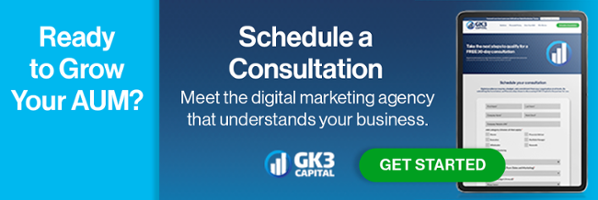Asset managers are forever looking for ways to help make their sales teams more efficient and productive. Unfortunately, employing traditional activity tracking and prospecting techniques that include making endless dials only to leave countless voicemails, no longer produce the same desired results.
The Rise of Sales Enablement
Over the past decade, new digital technologies and analytics capabilities have emerged that inform organizations on ever-changing buyer behaviors well before they ever meet with a member of the sales team.
HubSpot defines sales enablement as “the iterative process of providing such resources to your business’s sales team so they can use it to close more deals.” These resources may include content, messaging, automation tools, and data to effectively sell your product or service to customers at scale.

Sales enablement is designed to equip your sales team with insights needed to effectively engage with a sophisticated audience with high expectations, meaning the right prospects at the right time and with the right message. To do that, sales enablement uses tools to connect your content, marketing, and the sales cycle.
Gk3 Capital has been executing sales enablement strategies for clients since its inception, and we have found the following three key aspects essential for an asset manager’s success.
1. Technology and Automation

Technology is the driving force behind the automation processes that helps extract data and inform the sales enablement platforms that allow asset managers to boost sales performance. Here are two of the most effective technology tools used within sales enablement platforms:
Email Sequences
Email sequences are pre-built to automatically trigger if a prospect hasn't responded to a wholesaler or a digital engagement within a defined amount of time. These emails can be personalized and are used to encourage “next-step” engagement and keep a prospect moving along their discovery journey.
Automate Prospecting
Automatic prospecting is not the generic blast email approach that may come to mind. As mentioned, that method no longer works. Rather, automatic prospecting is a set of emails sent from a wholesaler that includes relevant messaging and direct links to their calendar, where prospects who are ready to have a conversation can easily schedule a meeting. The wholesaler simply reviews their calendar daily and knows that any scheduled appointments are likely to be with prospects who are well along in their buyer’s journey.
2 . Optimizing Content

Today personalized content is table stakes for moving a prospective client through their buyer’s journey. No longer will generic content blasted to a random group of prospects work. In fact, that approach is likely to offend most to the point they will never entertain your investment solutions. Two sales enablement tactics can help you optimize your content.
Create Case Studies
Case studies are one of the most valuable pieces of content a sales team can use. An existing client’s success can add immediate weight and respectability to your organization and the solutions you offer.
Recognizing how effective case studies can be, many asset managers prioritize case study creation within 6-12 months of a new product launch or a challenge that existing investment solutions helped solve. Sales enablement tools help track the engagement of case studies, revealing those prospects who show the most interest.
Create Email Templates
Despite the proliferation of emails we now receive, email continues to be one of the best ways your sales organization can connect with prospective clients. But today, executing email campaigns effectively requires the full use of sales enablement tools. Historically, a wholesaler could spend hours trying to personalize emails with the hope that advisors would read them and be open to a conversation. That was a costly and useless endeavor.
Fortunately, sales enablement tools now allow for the automatic dissemination of personalized emails to prospects with content that addresses the exact spot they’re at in their buyer's journey. In addition, standardized email templates are available to wholesalers as a sales enablement tool, allowing them to easily customize messages and dramatically increase productivity.
3 . Reporting and Analysis

Today’s wholesaling teams are driven by data, or at least they should be. But all too often, the volume of information now available can stall productivity as sales team members try to discern what data are beneficial and which are not. Sales enablement tools can help reduce that confusion in a few key ways:
Standardize Reporting
While reporting requirements may vary from one firm to another, agreeing on a set of standardized sales reports will help you extract the data that is most valuable for your sales organization. Your reports should include the following:
- Sales activity logged
- Leads generated and worked
- Product demos delivered
- Deals won and lost
While sales leadership generally knows the metrics that are most important, sales enablement can help deliver the data they need in a way that provides actionable learnings.
Audit Your Sales Process
It may be natural to assume you have an optimal sales process, but it’s important to take a step back and evaluate every aspect of it. You will likely find some common areas where sales break down. A thorough audit can help you identify those areas of weakness and highlight the sales enablement tools that allow you to close the gaps.
Qualify Leads Using Signals
Historically, the chasm that often exists between marketing and sales teams can be attributed to wholesalers not receiving the quality leads they need. Conversely, marketing would argue they provide good leads, but sales doesn’t use them properly.
Sales enablement tools can help create better synergy among the groups by collecting “signals” - nuggets of an advisor’s engagement activity throughout their journey - scoring that activity as to the quality and readiness of the lead, and then informing the wholesaler of when the advisor is ready to be contacted and what content they’re seeking.
Asset managers can use sales enablement tools with their CRMs to surface prospects to sales the minute they hit a pre-identified lead scoring level. Less qualified prospects can be moved to a CRM queue and placed in an email nurture campaign that continues to encourage further engagement.
While the tools and tactics discussed in this article are not an exhaustive list of all sales enablement capabilities, these are certainly several of the key elements that are instrumental in driving new sales and growing AUM. We encourage you to download our latest eBook, "Asset Manager's Guide to Digital Distribution" to discover how sales enablement can help you get in front of and engage new advisors in the way they prefer to interact with your organization in today’s digitally-empowered world.
Topics: Content Digital Marketing Digital Distribution Asset Management Website Sales Enablement CRM Automation Lead Generation Technology


.png)
